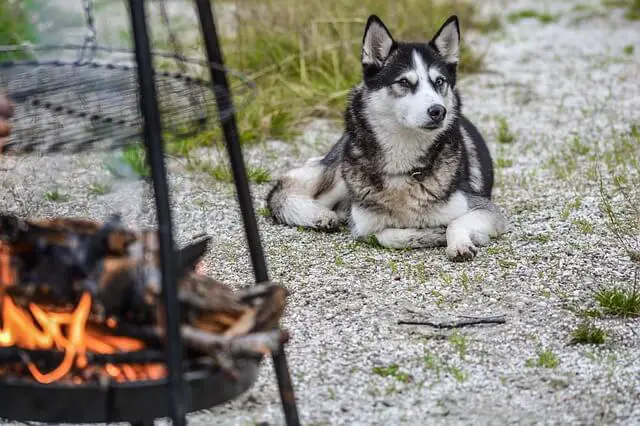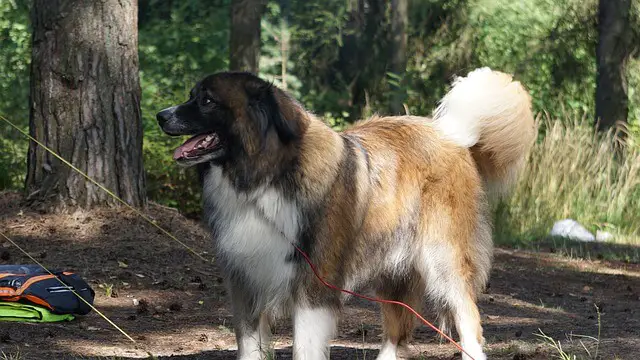Dogs & Campfire: Dangers of Smoke Inhalation
27.01.2022.
One of the things we were most excited about when we became dog owners was taking our dogs camping. We love spending time outdoors, and camping is one of our favorite ways to spend holidays and time off work. Naturally, we couldn’t wait to take our dogs with us. Before we did that, we wondered whether bonfires and smoke affect our dogs. You should know a few things about taking your dog camping and how smoke inhalation can affect your dog.
Can dogs be near campfires?
If precautions were taken, there is no reason dogs cannot be close to campfires. Some dogs will naturally feel uneasy close to flames, so you should never force your dog to stay closer to the campfire than they’re comfortable with. Your dog might feel better spending time in a tent and watching you from a distance. Here are a few things you need to ensure if you’re planning on spending time close to a campfire;
- Dogs should not be too close to the fire because their coats can catch flames. Even embers and ash can cause burns, so make sure the dog is at a safe distance.
- The dog should stay on the opposite side of the smoke. Their lungs are delicate, and you don’t want to place your dog in a position where the smoke will impact the dog’s health.
- Your dog should have access to plenty of water. Campfires can be pretty warm, especially large ones. If your dog is warm, they will need plenty of water. Make sure they can always reach fresh water.
- Puppies, senior dogs, and brachycephalic breeds, like the Bulldog, can quickly get irritated by smoke. It is essential to keep them away from potential harm.
- If you have a fire pit, you should ensure your dog cannot reach it. Dogs are curious, and their curiosity sometimes leads them in harm’s way.
WORLD DOG FINDER TIP: We know you (like we) were looking forward to camping with your dog, but you should know that some dogs are afraid of fire. They come from wolves, and they associate fire, heat, and smoke with the destruction of their habitat. Sometimes, no matter how much you try, your dog will simply not want to come anywhere near a fire.

Smoke inhalation in dogs
One of the things that are potentially very dangerous for dogs is smoke inhalation. This issue happens more often than dogs getting burnt on a camping trip. In fact, accidents like smoke inhalation, stepping on broken glass, or running away are more common than burns. We will focus on the dangers of smoke inhalation in dogs. You have to make sure your dog is not in the way of smoke. You and your dog should stay safe at all times.
How do I know if my dog inhaled smoke?
The first sign of smoke inhalation in dogs is that a dog was sitting in a place where the smoke was blowing. The exact symptoms will vary depending on the amount of smoke the dog inhaled, the temperature of the smoke, and the burned chemicals. Most dog owners will notice their dogs are behaving weirdly, which is when they call their vets and learn about the dangers of smoke inhalations.
Symptoms of smoke inhalation in dogs
The easiest and quickest way to know your dog inhaled too much smoke is to learn the symptoms. If the dog’s health is affected by smoke, they will exhibit specific signs. As we already mentioned, these signs will vary depending on the burnt chemicals. Here are the most common symptoms of smoke inhalation in dogs;
- Squinting
- Rapid breathing
- Irregular breathing
- Skin burns
- Uncoordinated gait
- Seizures
- Facial swelling

How will smoke inhalation affect my dog?
If you ever had the unpleasant experience of inhaling smoke, you know how irritating it can be. The whole airway system becomes irritated, and your lungs start burning. You will try to cough the smoke out, but it is already “stuck” to the lungs. Smoke inhalation in dogs is very dangerous and can lead to life-threatening complications. Here are 5 potential issues that can affect your dog;
- Carbon monoxide poisoning - Carbon monoxide will affect how the red blood cells transfer oxygen to all parts of the body. If that happens, the dog can die.
- Thermal injury - One of the first things that happen to dogs when they inhale smoke is thermal injury. Hot air will travel through the dog’s airways and cause irritation, swelling, and burns.
- Hydrogen cyanide poisoning - Hydrogen cyanide is a by-product of burning different chemicals and plastic. It will affect the dog in a similar way as carbon monoxide. Avoid burning things like plastic bottles in the campfire.
- Pneumonia - Pneumonia usually happens some time after smoke inhalation. Smoke will weaken the lungs’ “defenses” and lower their ability to prevent viruses and bacteria from infecting them.
- Neurologic disorders - One of the possible things that can happen after smoke inhalation is a neurological disorder. Dogs can have problems walking, develop seizures, and change their usual behavior.
What should I do if my dog inhaled smoke?
Smoke inhalation is considered a medical emergency, especially if the dog is exposed to a lot of smoke or smoke that comes from burning plastic or chemicals. The only thing you can do is bring your dog to a pet ER as soon as possible. The first thing the vet will check is what type of smoke your dog inhaled. The good news is that there are drugs that can help dogs get rid of hydrogen cyanide, so your vet will want to know as much as they can.
Smoke inhalation is usually treated with oxygen therapy, and the results can be pretty good. However, the dog should be brought to the vet early. The main problem is that complications can happen hours or days after smoke inhalations. Some airway problems are progressive, so neither owners nor vets can spot them immediately. After the dog receives oxygen therapy, vets recommend owners keep a close eye on them.
World Dog Finder team







Share